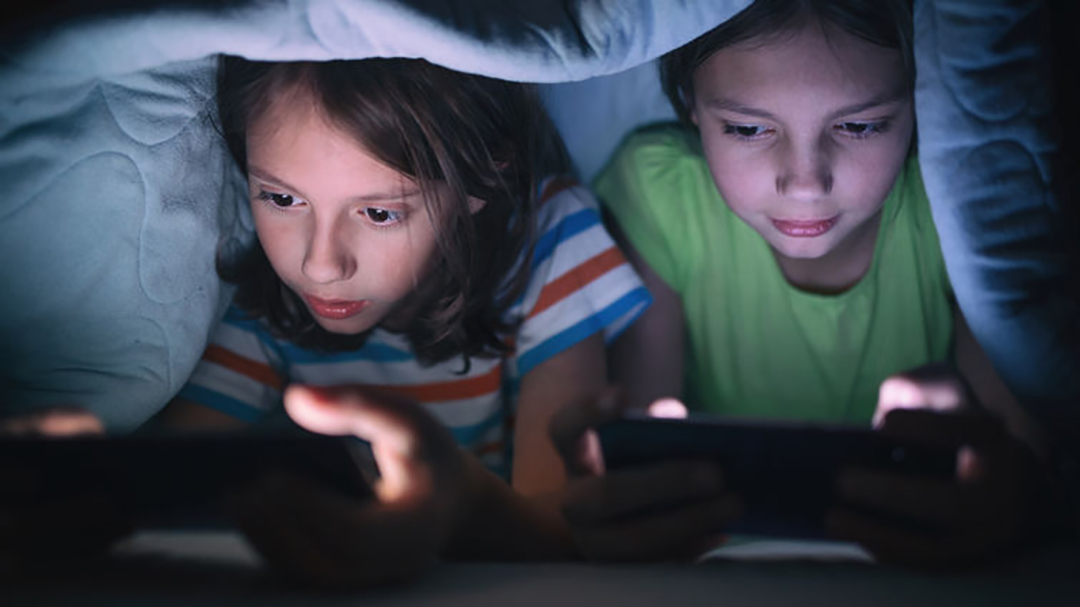Screens are everywhere—tablets, phones, TVs, game consoles, and laptops. For most families, they’re part of everyday life (and let’s be honest, a lifesaver during dinner prep). But when screen time creeps into the evening hours, it can quietly disrupt something crucial to your child’s well-being: their sleep.
The culprit? Blue light.
If your child struggles to fall asleep, tosses and turns at night, or wakes up groggy and cranky, blue light overload might be to blame. The good news? There are simple, science-backed ways to create a safer nighttime routine—and it doesn’t mean giving up screens entirely.
Let’s dive into the why, and how to fix it.
What Is Blue Light—and Why Does It Matter?
Blue light is a type of high-energy light naturally emitted by the sun, which helps regulate our circadian rhythm (our internal body clock). It signals our brain that it’s time to wake up and be alert.
- In the morning? Blue light = great.
- At night? Blue light = problem.
Screens emit artificial blue light that tricks the brain into thinking it’s still daytime—even after the sun goes down.
This delays the body’s release of melatonin, the sleep hormone, making it harder for kids (and adults!) to wind down and fall asleep.
Poor Sleep in Kids Is No Small Thing
When kids don’t get enough quality sleep, it doesn’t just show up as yawns—it can look like:
- Meltdowns or mood swings
- Trouble focusing at school
- Weakened immune function
- Poor appetite or digestive issues
- Increased anxiety or hyperactivity
And unfortunately, many parents try everything—earlier bedtimes, white noise machines, lavender baths—but don’t realize the light from screens is silently sabotaging their efforts.
So What Can You Do?
1. Set a Screen Curfew
Ideally, turn off all screens 1–2 hours before bedtime to give your child’s body a chance to naturally increase melatonin levels.
If that’s not realistic, even 30 minutes off-screen before bed can make a huge difference.
2. Use Blue Light Blockers
If screens are unavoidable at night (homework, travel, downtime), consider tools that reduce blue light exposure:
- Blue light blocking glasses (Use code DRLENA for 15% off all products!)
- Night mode or “warm screen” settings on tablets and phones
- Dim, amber-toned lighting in bedrooms instead of bright overhead lights
These won’t cancel out all the effects—but they help reduce the overall impact.
3. Create a Calming Pre-Bedtime Routine
Replace screens with soothing, melatonin-friendly activities:
- Reading a physical book
- Drawing or journaling
- Listening to calming music or audiobooks
- Doing a short meditation, prayer, or bedtime stretch
You can also make bathtime a powerful part of your child’s wind-down routine. A warm bath with Epsom salts can help relax muscles and support magnesium levels, while lavender-scented shampoo or lotion can signal to the body that it’s time for rest. I love the Rowe Casa Organics Kids Sleep Bath Bombs—they’re gentle, toxin-free, and infused with calming essential oils. You can grab them here: Rowe Casa Organics Sleep Bath Bombs and use code LENA for 20% off.
Kids crave structure—even if they fight it at first. The more consistent the routine, the easier their body can shift into rest mode.
4. Support Their Sleep Nutritionally
Evening routines aren’t just about habits—they’re also about supporting the nervous system and sleep hormones with the right nutrients.
Some of our favorite supplements and tools include:
- Magnesium (calms the body + relaxes muscles)
- Chamomile tea or kid-safe herbal blends
- Morning Vitamin D3 to help regulate the sleep/wake cycle
- Trace minerals to support melatonin production
- Red or amber night lights instead of white or blue ones
Need help picking the right bedtime support for your child? Ask us in-office—we’re happy to recommend the cleanest, safest products based on your child’s age and needs.
What If My Child Still Has Sleep Issues?
If your child is still struggling to sleep, or wakes frequently, there may be deeper imbalances at play—especially in the gut, immune system, or nervous system.
Common root causes we explore include:
- Food allergies causing nighttime inflammation
- Nutrient deficiencies (like magnesium, B6, or iron)
- Elevated cortisol or stress hormones
- Gut dysbiosis disrupting melatonin production
- Mycotoxicity
In our clinic, we offer comprehensive testing to uncover what’s really keeping your child up at night—and personalized plans to help them finally rest and recharge.
Sleep Is the Foundation of Healing
Kids need good sleep to grow, focus, heal, and thrive. And sometimes, the simplest shift—like turning off screens a little earlier—can change everything.
Want help designing a better bedtime routine?
Curious if your child’s sleep troubles are linked to deeper issues?
A new school year means new routines, new friends—and unfortunately, new exposures to germs and potential triggers that can affect your child’s health, focus, and energy. That’s why we’ve created our Back-to-School Bundle to help you start the year strong.
For only $499, you’ll receive:
- Immuno Food Allergy Kit – A simple, at-home test that identifies hidden food allergies and allergies that may be contributing to digestive issues, skin problems, mood swings, and focus challenges.
- Food Education Consultation – A personalized session to review your child’s results and create a kid-friendly nutrition plan to support their gut, immune system, and overall well-being.
This package takes the guesswork out of what’s really going on with your child’s health, so you can make confident decisions about their diet and lifestyle—without wasting money on trial and error.
Get your child’s Back-to-School Bundle for just $499 and give them the healthiest start to the school year possible.
Let’s help your child wind down naturally and wake up feeling like their best self—every single day.

